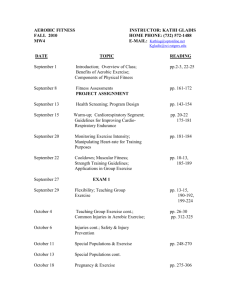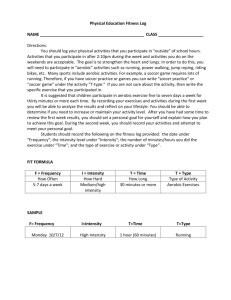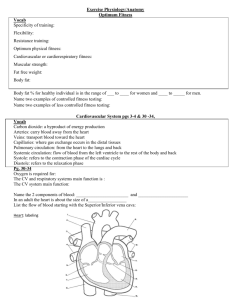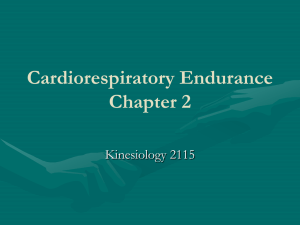wellnesscourse lesson 3 - TLU Faculty and Staff Web Pages
advertisement
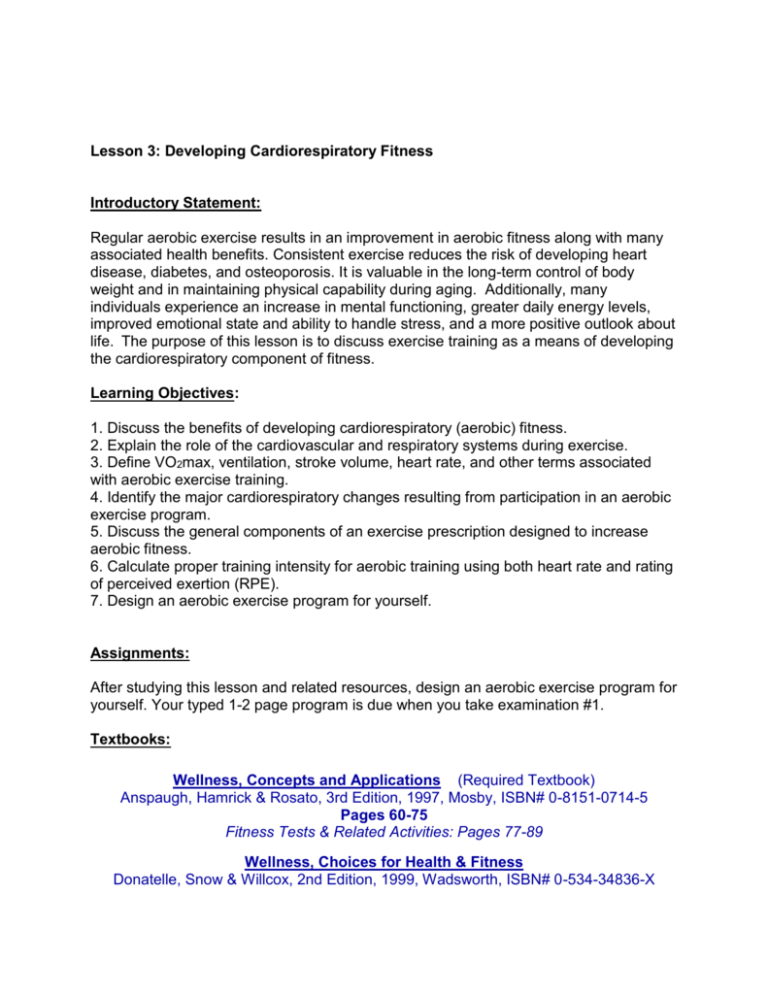
Lesson 3: Developing Cardiorespiratory Fitness Introductory Statement: Regular aerobic exercise results in an improvement in aerobic fitness along with many associated health benefits. Consistent exercise reduces the risk of developing heart disease, diabetes, and osteoporosis. It is valuable in the long-term control of body weight and in maintaining physical capability during aging. Additionally, many individuals experience an increase in mental functioning, greater daily energy levels, improved emotional state and ability to handle stress, and a more positive outlook about life. The purpose of this lesson is to discuss exercise training as a means of developing the cardiorespiratory component of fitness. Learning Objectives: 1. Discuss the benefits of developing cardiorespiratory (aerobic) fitness. 2. Explain the role of the cardiovascular and respiratory systems during exercise. 3. Define VO2max, ventilation, stroke volume, heart rate, and other terms associated with aerobic exercise training. 4. Identify the major cardiorespiratory changes resulting from participation in an aerobic exercise program. 5. Discuss the general components of an exercise prescription designed to increase aerobic fitness. 6. Calculate proper training intensity for aerobic training using both heart rate and rating of perceived exertion (RPE). 7. Design an aerobic exercise program for yourself. Assignments: After studying this lesson and related resources, design an aerobic exercise program for yourself. Your typed 1-2 page program is due when you take examination #1. Textbooks: Wellness, Concepts and Applications (Required Textbook) Anspaugh, Hamrick & Rosato, 3rd Edition, 1997, Mosby, ISBN# 0-8151-0714-5 Pages 60-75 Fitness Tests & Related Activities: Pages 77-89 Wellness, Choices for Health & Fitness Donatelle, Snow & Willcox, 2nd Edition, 1999, Wadsworth, ISBN# 0-534-34836-X Pages 55-80 Fitness Test & Assessing Heart Rate: Pages 81-83 Total Fitness, Exercise, Nutrition, and Wellness Powers & Dodd, 2nd Edition, 1999, Allyn & Bacon, ISBN# 0-13-095894-8 Pages 74-97 Exercise Prescription Form & Training Log: Pages 99-101 WWW Links: Shape Up America: http://www.shapeup.org This site, by Ex-U.S. Surgeon General C. Everett Coop, is really neat. It has just the right amount of information to be easily used and some great fitness assessments you can complete yourself to have the site interpret for you. This is a must site to hit! Georgia State University Dept. of Kinesiology and Health Website: http://www.gsu.edu/~wwwfit/ This site contains research-based information on fitness: aerobic, strength, and flexibility training, exercise adherence, nutrition and body composition, and advice for special populations. Another must site to visit if you are developing your own fitness program. Fitness Partner Connection Jumpsite: http://www.primusweb.com/fitnesspartner/ A huge fitness site with a searchable library, links to other sites, and a caloric expenditure calculator. A good place to start a search on fitness-related topics. Wellness Interactive Network: http://www.stayhealthy.com A good place to start an information search because it links to so many other good sites--allowing the student an overview of the many additional sites available for inspection. This comprehensive wellness site includes links to all aspects of health and wellness. It contains a good health risk assessment questionnaire, a searchable database for drug/medical information, electronic newsletters, and information concerning electronic mailing lists and newsgroups. Sympatico: http://www.ns.sympatico.ca/healthyway Includes articles about health/fitness, book reviews, and links to other nutrition, fitness, and wellness sites. BCPL's Net Guide to Health Resources: http://www.bcpl.lib.md.us/centers/health.html A good place to start searching for information and activities. This site contains a large number of links to other wellness/health resources such as web sites, books, etc. Medsite.com: http://www.medsite.com A large search engine of health/medical topics. Well indexed. Disabled Sports USA: http://www.dsusa.org/~dsusa/#sports Information of interest to disabled athletes and their supporters. Key Terms: aerobic exercise VO2max cardiorespiratory system acute exercise response chronic exercise response heart rate stroke volume blood pressure ventilation exercise prescription mode (of exercise) frequency (of exercise) duration (of exercise) intensity (of exercise) progression (of exercise) cross-training target heart rate training zone (THR) rating of perceived exertion (RPE) Summary Lecture Notes: Exercises that rely on the heart and lungs to supply oxygen to the working muscles for energy production are called cardiorespiratory or "aerobic" activities. Aerobic exercises involve large muscle groups, in a rhythmical fashion, at low-to-moderate intensities, for extended periods of time. For example, walking, jogging, swimming, cycling and aerobic dance are all considered aerobic exercises when conducted at appropriate intensities. The most accurate method of determining level of aerobic conditioning is by measuring the maximal amount of oxygen the body can take in, transport, and use to form energy. The direct measurement of these capabilities can only be done in a laboratory and is called the VO2max, or maximal oxygen consumption. Regular aerobic exercise results in an improvement in aerobic fitness (VO2max) along with associated health benefits. Consistent exercise reduces the risk of developing heart disease, diabetes, and osteoporosis. It is valuable in the long-term control of body weight and in maintaining physical capability during aging. Additionally, many individuals experience an increase in mental functioning, greater daily energy levels, improved emotional state and ability to handle stress, and a more positive outlook about life. The cardiorespiratory system refers to the heart/circulatory system, which transports oxygen and nutrients in the blood to the working muscles, and the respiratory system, which loads oxygen into and removes carbon dioxide from the blood. Acute responses are those that occur during exercise, and include increases in heart rate, stroke volume (amount of blood pumped per beat) and blood pressure, all of which result in greater blood flow to the working muscles. Ventilation (breathing) also increases in order to meet the oxygen loading and carbon dioxide unloading requirements during exercise. Chronic responses (longer-term adaptations) include an increase in VO2max resulting from a greater stroke volume and specific muscle cell changes. Due to the increase in stroke volume with training, heart rate decreases at rest and during submaximal exercise. This indicates an improvement in aerobic conditioning. Most healthy people can begin a low or moderate exercise program without the need for a medical evaluation. Those having risk factors for heart disease, joint problems, or who have been sedentary and are beyond age 40 (50 for women) should consult with their physician before beginning an exercise program, especially if it is vigorous. Certainly, anyone with symptoms and/or known cardiovascular disease or diabetes should have a medical check-up prior to beginning an exercise program. As stated in lesson 2, an exercise prescription should include guidance concerning the mode or method (what to do), frequency (how often), duration (how long), intensity (how hard), and progression (stages) of the exercise program. The following guidelines relate to achieving “health-related” fitness. For cardiovascular (aerobic) fitness, the mode should include exercises that utilize large muscle groups, are rhythmic, safe, and can be easily continued for long periods of time at moderate intensity. Good aerobic activities include, but are not limited to: brisk walking, jogging, rollerblading, stationary and road cycling, aerobic dance, and swimming. The activity should be one the participant enjoys, has the equipment, knowledge and skill to perform, and can be conveniently practiced. The frequency of aerobic activity depends somewhat on lifestyle and whether body weight control is a goal. A frequency range of 3-7 days per week is the standard recommendation. Although increases in aerobic fitness may result from exercising as little as 3 days per week, those wishing to lose body weight or who enjoy exercising more often, may exercise 5-7 days per week. If exercising often, adults should not engage in high-impact activities (those such as jogging, where the body becomes temporarily airborne) on successive days or else repetitive strain injuries might occur. Cross-training, or mixing of activities, is an effective way to train on successive days, fight boredom, and reduce the chances of developing overuse injuries. Aerobic exercises should be continued for longer periods of time at low-moderate intensity. The duration should be 20-60 minutes of continuous activity for most adults. For example, most adults can complete a 3-mile brisk walk in 45-60 minutes. Those with specific health problems or low exercise tolerance can benefit from breaking the 30-60 minutes up into several shorter exercise sessions. Additionally, a good rule for busy adults is to avoid exercise sessions which last beyond one hour. Proper intensity of aerobic activity is important for safety and effectiveness reasons. The standard recommended range is 50-85% of VO2max, or 12-16 on the RPE (Rating of Perceived Exertion—discussed below). Those with very poor fitness levels and/or other health problems may, however, benefit from exercise intensities as low as 40% VO2max, and 10 on the RPE. It is wise to keep intensity low during the initial stage of the aerobic exercise program and then proceed to gradually increase to moderate intensity during the improvement stage. Click the link below to see instructions on how to calculate an appropriate target heart rate training zone (THR) and an explanation of the rating of perceived exertion scale (RPE). (insert link to calculation of target heart rate training zone and rpe) The aerobic exercise program should progress from an initial, “break-in” stage of approximately 3-weeks, to an improvement stage lasting about 6-months, to lifetime maintenance of the fitness habit. As stated in lesson 2, the goal of progression is to gradually overload the aerobic system by increasing the frequency, duration and intensity of the activity until arriving at a reasonable, appropriate amount of exercise that can be maintained for life. It is important, when overloading for aerobic conditioning and weight control, to increase the duration of the exercise session before increasing the intensity. (insert link to week-by-week CV training program found in Powers wellness book) Questions: 1. Exercises that rely on the heart and lungs to supply oxygen to the working muscles are called a. anaerobic exercises b. aerobic exercises c. oxygenated exercises d. glycolytic exercises e. none of the above 2. Which of the following is not characteristic of an aerobic activity? a. involves mostly large muscle groups b. is rhythmical in nature c. performed at high intensities for short periods of time d. all of the above are characteristics 3. The system involved in the transportation of oxygen in the blood to the working muscles for energy formation is called the a. endocrine system b. digestive system c. respiratory system d. cardiovascular system e. none of the above 4. A “chronic” response to exercise includes the a. increase in blood pressure b. increase in VO2max c. increase in ventilation d. increase in heart rate e. none of the above; all are “acute” responses to exercise 5. The intensity of exercise in an exercise prescription refers to a. the number of sessions of exercise per week b. the length of time for each exercise session c. the stages involved in the exercise program d. the method (mode) of exercise e. none of the above 6. An example of a good aerobic exercise activity is a. stationary cycling b. lap swimming c. jogging d. walking e. all of the above 7. A person with the goals of health-related fitness and bodyweight control should exercise at least ___________ days per week. a. 1 b. 3 c. 5 d. none, if bodyweight control is a goal 8. Exercising using a mixture of activities is called a. anaerobic training b. aerobic training c. superset training d. cross-training e. none of the above 9. The duration range of an aerobic exercise session for most adults should be approximately a. 5 minutes b. 5-20 minutes c. 20-60 minutes d. 60-90 minutes e. none of the above 10. When training aerobically, it is important to keep intensity high and duration short. a. true b. false 11. The proper intensity range for an aerobic exercise session for most adults should be approximately a. 15-30% VO2max b. 30-50% VO2max c. 50-85% VO2max d. 70-90% VO2max e. none of the above 12. The proper intensity range for an aerobic exercise session for most adults using the RPE scale is a. 3-8 b. 8-12 c. 12-16 d. 16-20 e. none of the above 13. The “initial” stage of an exercise program involves the rapid increasing of intensity, frequency or duration in order to overload the cardiorespiratory system. a. true b. false 14. Most healthy adults can begin a moderate exercise program without first having a medical evaluation. a. true b. false 15. A person should progress to the next level of an aerobic exercise training plan as scheduled regardless of how they felt during the current level of exercise. a. true b. false Answers: 1. B 2. C 3. D 4. B 5. E, how hard to exercise during the exercise session 6. E 7. C 8. D 9. C 10. B 11. C 12. C 13. B 14. A 15. B Score Interpretation: 14 – 15 correct = excellent 12 – 13 correct = good 10 – 11 correct = average 08 – 09 correct = below average < 08 correct = needs improvement Other:
